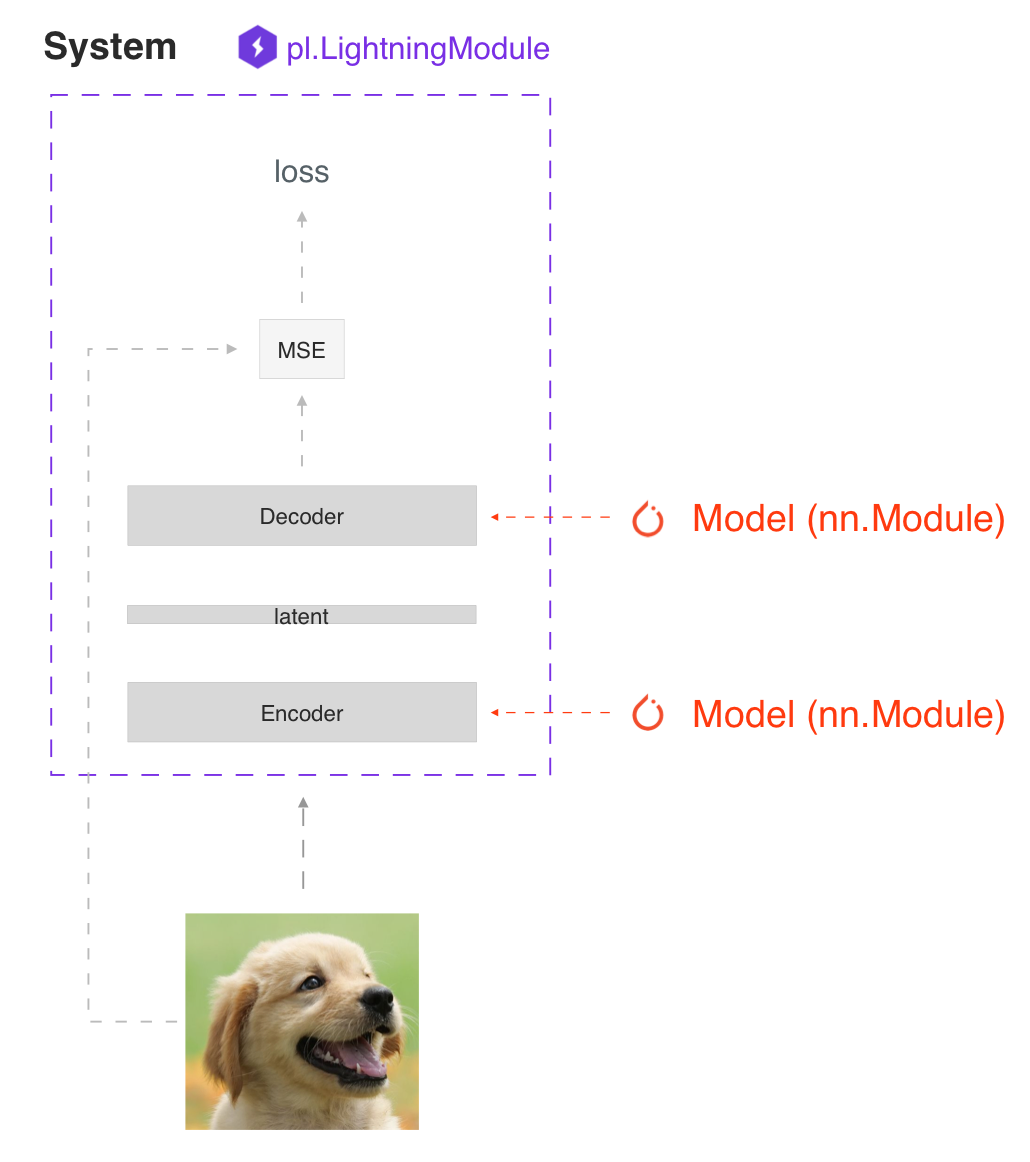Style guide¶
A main goal of Lightning is to improve readability and reproducibility. Imagine looking into any GitHub repo, finding a lightning module and knowing exactly where to look to find the things you care about.
The goal of this style guide is to encourage Lightning code to be structured similarly.
LightningModule¶
These are best practices about structuring your LightningModule
Systems vs models¶

The main principle behind a LightningModule is that a full system should be self-contained. In Lightning we differentiate between a system and a model.
A model is something like a resnet18, RNN, etc.
A system defines how a collection of models interact with each other. Examples of this are:
GANs
Seq2Seq
BERT
etc
A LightningModule can define both a system and a model.
Here’s a LightningModule that defines a model:
class LitModel(LightningModule):
def __init__(self, num_layers: int = 3):
super().__init__()
self.layer_1 = nn.Linear()
self.layer_2 = nn.Linear()
self.layer_3 = nn.Linear()
Here’s a LightningModule that defines a system:
class LitModel(LightningModule):
def __init__(self, encoder: nn.Module = None, decoder: nn.Module = None):
super().__init__()
self.encoder = encoder
self.decoder = decoder
For fast prototyping it’s often useful to define all the computations in a LightningModule. For reusability and scalability it might be better to pass in the relevant backbones.
Self-contained¶
A Lightning module should be self-contained. A good test to see how self-contained your model is, is to ask yourself this question:
“Can someone drop this file into a Trainer without knowing anything about the internals?”
For example, we couple the optimizer with a model because the majority of models require a specific optimizer with a specific learning rate scheduler to work well.
Init¶
The first place where LightningModules tend to stop being self-contained is in the init. Try to define all the relevant sensible defaults in the init so that the user doesn’t have to guess.
Here’s an example where a user will have to go hunt through files to figure out how to init this LightningModule.
class LitModel(LightningModule):
def __init__(self, params):
self.lr = params.lr
self.coef_x = params.coef_x
Models defined as such leave you with many questions; what is coef_x? is it a string? a float? what is the range? etc…
Instead, be explicit in your init
class LitModel(LightningModule):
def __init__(self, encoder: nn.Module, coeff_x: float = 0.2, lr: float = 1e-3):
...
Now the user doesn’t have to guess. Instead they know the value type and the model has a sensible default where the user can see the value immediately.
Method order¶
The only required methods in the LightningModule are:
init
training_step
configure_optimizers
However, if you decide to implement the rest of the optional methods, the recommended order is:
model/system definition (init)
if doing inference, define forward
training hooks
validation hooks
test hooks
configure_optimizers
any other hooks
In practice, this code looks like:
class LitModel(pl.LightningModule):
def __init__(...):
def forward(...):
def training_step(...):
def training_step_end(...):
def training_epoch_end(...):
def validation_step(...):
def validation_step_end(...):
def validation_epoch_end(...):
def test_step(...):
def test_step_end(...):
def test_epoch_end(...):
def configure_optimizers(...):
def any_extra_hook(...):
Forward vs training_step¶
We recommend using forward for inference/predictions and keeping training_step independent
def forward(self, x):
embeddings = self.encoder(x)
def training_step(self):
x, y = ...
z = self.encoder(x)
pred = self.decoder(z)
...
However, when using DataParallel, you will need to call forward manually
def training_step(self):
x, y = ...
z = self(x) # < ---------- instead of self.encoder(x)
pred = self.decoder(z)
...
Data¶
These are best practices for handling data.
Dataloaders¶
Lightning uses dataloaders to handle all the data flow through the system. Whenever you structure dataloaders, make sure to tune the number of workers for maximum efficiency.
Warning
Make sure not to use ddp_spawn with num_workers > 0 or you will bottleneck your code.
DataModules¶
Lightning introduced datamodules. The problem with dataloaders is that sharing full datasets is often still challenging because all these questions need to be answered:
What splits were used?
How many samples does this dataset have?
What transforms were used?
etc…
It’s for this reason that we recommend you use datamodules. This is specially important when collaborating because it will save your team a lot of time as well.
All they need to do is drop a datamodule into a lightning trainer and not worry about what was done to the data.
This is true for both academic and corporate settings where data cleaning and ad-hoc instructions slow down the progress of iterating through ideas.
